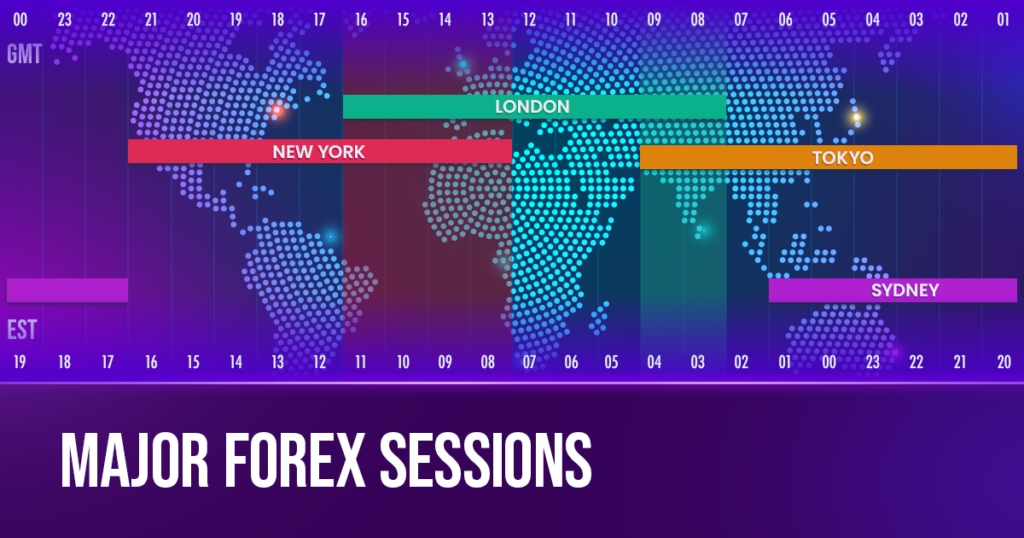I. Introduction
If you’re interested in trading Forex, it’s important to understand when the market is most active and volatile. The Forex market is open 24/5, meaning it’s only closed during the weekends and bank holidays, but that doesn’t mean you’ll always see movement in the market. To make the most of your trades, you need to know when to buy and sell.
In this article, you’ll learn how to capitalize on the unique characteristics of each time zone and develop tailored strategies for success. If you’re already confident in your knowledge of forex sessions and eager to put your skills to the test, sign up with True Forex Funds to become a funded trader and start reaping the rewards of your expertise.
If you’re ready for the challenge, get started with True Forex Funds
Get fundedThe Major Forex Sessions at a Glance
The Forex market is global, which means that it operates across different time zones. To simplify things, the market is divided into four major trading sessions:
- London: 8 am – 4 pm (GMT)
- New York: 1 pm – 10 pm (GMT)
- Sydney: 8 pm – 6 am (GMT)
- Tokyo: 12 am – 9 am (GMT)
Keep in mind that daylight savings time adjustments may apply.

The Benefits of Knowing Forex Trading Hours
Understanding Forex trading hours and time sessions can empower you to pinpoint the optimal times to trade based on time zone and currency pair. For instance, during the Tokyo Forex market hours, the Japanese Yen is heavily traded, making it an ideal time to trade the USD/JPY and EUR/JPY pairs.
Furthermore, grasping Forex holiday schedules can help you sidestep trading during low liquidity periods, reducing the risk of losses. By understanding the different Forex time sessions, you can make informed trading decisions and improve your chances of success in the Forex market.
II. History and Purpose of the Four Major Forex Sessions
The Bretton-Woods Agreement in 1944 laid the foundation for the global forex market, establishing a $35/ounce gold-dollar peg, meaning that an ounce of gold was worth $35 in US currency. This system aimed to provide stability for international currencies. However, when the US government removed the peg in 1971 due to mounting economic pressures, it led to the collapse of other similar pegs, paving the way for the forex market’s evolution.
The true revolution came with the advent of internet technology in the 1990s, which made trading faster and more globalized. Banks could now deal with clients outside their geographical location, and new markets emerged. Investors in the US could speculate on Asian currencies, while hedge funds in Europe could trade in Asian and North American currencies to seek profit.
This globalization led to the development of the 24-hour forex market, which operated round-the-clock because it didn’t rely on a centralized venue but rather a network of computers, servers, routers, and trading stations connected via the internet. However, active trading periods varied across the world, as humans remained the driving force behind trades and speculative activity within traditional business hours.
The rise of algorithms and artificial intelligence-driven trading systems, along with increasing workplace demands, is pushing the boundaries of these working hours. Yet, traditional business hours largely remain intact in many parts of the world, ensuring that Forex market activity corresponds to when the human workforce is active in their respective time sessions. Bank holidays provide occasional breaks from this cycle, causing market activity to dwindle during such times.

III. How the Four Major Trading Sessions Work
Every business day is a Forex trading day, involving a complex interplay between various market players. In essence, the Forex market operates through the functions and activities of investment banks, liquidity providers, retail brokers, and retail traders like you.
At the top end of the market, investment banks and liquidity providers engage in buy-side (portfolio management) and sell-side (market making) functions. As a funded trader with True Forex Funds, you’ll be operating at a different level. Liquidity providers make the market for their clients, who in turn offer the assets to retail traders via platforms like MT4, MT5, and cTrader. You can buy or sell these assets as part of your funded accounts, aiming to profit from them.
The distinct characteristics of each major trading session demand specific trading strategies to capitalize on unique price behaviors:
- London Time Zone:
Increased activity and liquidity characterize this zone, making it suitable for breakout strategies after identifying the highs and lows of the Tokyo and Sydney sessions. Higher volatility occurs later on when New York trading begins, and market-moving news leads to significant price shifts, which benefits scalpers.
- New York Time Zone:
The heaviest market activity defines this time zone, primarily due to its overlap with the London session. The overlapping hours are when crucial US news hits the newswires, creating opportunities for day traders, scalpers, and breakout traders who can capitalize on the heightened volatility.
- Tokyo/Sydney Time Zone:
In this session, price action typically trades within defined ranges, as market news during these hours doesn’t significantly affect prices. This period benefits range traders or those whose strategies aren’t dependent on breakouts.
In summary, the Forex market’s intricate workings result from the interactions between various players. As a funded trader, understanding the unique characteristics of each trading session and tailoring your strategies accordingly can help you make the most of the opportunities presented by the dynamic Forex market.
To learn about a popular trading strategy, scalping, read our Understanding Scalping Trading Strategies in Forex article.
IV. Differences and Similarities Between the Four Major Trading Sessions
During overlap periods, increased volatility arises from the participation of more market players from different zones, presenting the best opportunities for traders to exploit. The overlap periods bring more market volume, liquidity, and currencies into play, providing traders with greater trade options and opportunities.
Most Suitable Assets to Trade in Each Forex Time Session:
Currencies primarily used for daily transactions within each time zone tend to experience the most activity. Let’s also consider the pros and cons of trading in each market session, keeping in mind that location can affect a trader’s ability to participate in certain sessions.
London
European currencies like the Euro and Pound Sterling become more active. The EUR/USD, GBP/USD, EUR/GBP, USD/CHF, GBP/JPY, and EUR/JPY pairs experience high trading volumes. Activity in the Australian Dollar and Asian currencies is low during this time.
- Pros
- Good volatility with UK and European news, without the extreme fluctuations of the NY session.
- Overlap with NY session provides high volatility and lower market costs.
- Traders from Tokyo and Sydney can catch some market action.
- Correlated trades possible due to trading hours overlapping with commodities like crude oil, gold, and natural gas.
- Cons
- Early London session falls outside NY trading hours, limiting participation.
- Overlapping European market impact may create confusion and conflicts, making it challenging for newbies.
New York
The US Dollar is most active during this session. The EUR/USD and GBP/USD pairs are particularly popular due to the overlap with the London session. Gold also experiences high activity. Other USD pairs like USD/JPY, USD/CHF, USD/ZAR, USD/TRY, and USD/NOK can be traded, especially when market-moving news from the crude oil markets occurs.
- Pros
- Numerous news releases from the US create ample opportunities for news traders.
- Overlap with London session offers high liquidity, volatility, and cheaper market costs.
- Market-moving news from the NY session carries over into the next Tokyo and Sydney sessions.
- Cons
- High volatility, primarily due to US news, may be overwhelming for beginners.
- Tokyo and Sydney traders cannot directly participate in the NY session due to business hour differences, only trading the secondary impact of news.
Tokyo and Sydney
Asian and Oceania currencies such as the Japanese Yen, Chinese Yuan, Australian Dollar, and New Zealand Dollar are highly active. During the overlap hours (7 am – 9 am GMT), the AUD/USD, EUR/JPY, USD/JPY, and NZD/USD pairs are commonly traded, with the US Dollar being widely popular. Trades in the EUR/JPY and GBP/JPY also increase in anticipation of the London session.
- Pros
- A quieter trading session with mostly range-bound price action, suitable for beginners.
- Offers a smaller window of opportunity to profit from the secondary impact of NY session news.
- Cons
- Unsuitable for breakout strategies or scalping due to the range-bound nature.
- Relies on London or New York for leading market-moving news events.
Start your trading journey with True Forex Funds
Get fundedV. Tips for New and Experienced Traders
As traders, it’s essential to work within your time zone, understanding the most active currencies and CFDs in that period. True Forex Funds partners with multiple liquidity providers offering more than 110 instruments, ensuring you’ll find suitable assets for your trading schedule. Here are some practical tips for trading in various forex time zones:
- Prioritize sleep over trading in a specific time zone.
If your sleeping hours coincide with the most active market periods, remember that market-moving events can have a lasting impact. High-volatility news from the New York session often carries over into the Tokyo and Sydney sessions, so there’s no need for Asian traders to stay awake for NY session news.
- Master trading styles that suit a particular time zone.
Each forex time zone has distinct price behavior patterns. For example, Tokyo/Sydney sessions have tighter price ranges than London or New York sessions. Breakout traders may find the Asian sessions less favorable, while news traders might thrive during the overlap between London and New York sessions.
- Trade regularly to become accustomed to the timezone.
To stay in tune with a specific time zone’s price action, consistently trade within that period. Some traders excel at trading the pre-London session hour, where price breaks out from the Asian session ranges. Achieving such expertise requires regular trading and practice.
- Utilize well-capitalized accounts with solid risk management.
Trading in various time zones can be most effective with well-funded accounts and proper risk management practices. Consider signing up for True Forex Funds evaluation programs to access these conditions.
- Stay informed about global news and events.
Understanding the economic and political landscape in each region can help you anticipate market movements and make better-informed trading decisions.
Ready to try this in action? Get started with True Forex Funds!
Get fundedVI. Conclusion
In conclusion, this article has explored the four major Forex time zones and highlighted the essential aspects of trading within these periods. To excel in Forex trading, it’s crucial for traders of all experience levels to understand the price action and unique characteristics of each time zone, allowing them to choose the most suitable trading strategies.
Continuous learning and improvement are vital components of successful trading. Maintaining a trading journal, studying relevant material on time zone-specific strategies, and frequently trading within your preferred time zones will help you gain mastery of the market action.
The key takeaways from this article are to prioritize sleep, adapt your trading style to each time zone, trade regularly, and use well-capitalized accounts with solid risk management.
To put these insights into practice and test your knowledge, sign up for an evaluation to become a funded trader with True Forex Funds. Our evaluation programs offer an excellent opportunity to gain access to a well-funded account for successful participants, setting you on the path to Forex trading success.




